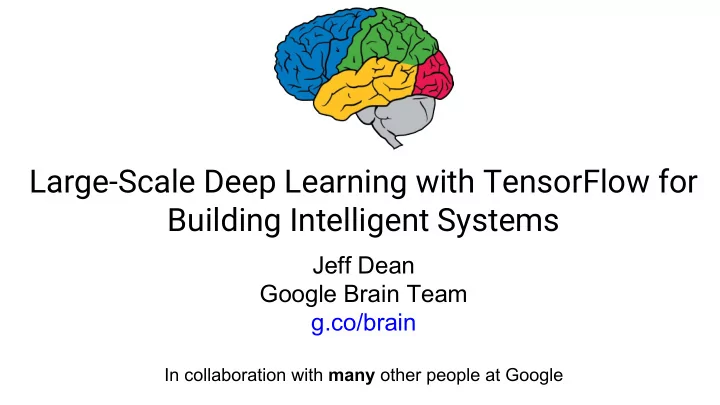

Sequence-to-Sequence Model: Machine Translation Target sentence [Sutskever & Vinyals & Le NIPS 2014] How tall are you? v Quelle est votre taille? <EOS> Input sentence
Sequence-to-Sequence Model: Machine Translation Target sentence [Sutskever & Vinyals & Le NIPS 2014] v Word w2 w3 w4 <EOS> Input sentence
Smart Reply April 1, 2009: April Fool’s Day joke Nov 5, 2015: Launched Real Product Feb 1, 2016: >10% of mobile Inbox replies
Smart Reply Google Research Blog - Nov 2015 Incoming Email Activate Smart Reply? Small Feed- Forward yes/no Neural Network
Smart Reply Google Research Blog - Nov 2015 Incoming Email Activate Smart Reply? Small Feed- Forward yes/no Neural Network Generated Replies Deep Recurrent Neural Network
Sequence-to-Sequence ● Translation: [Kalchbrenner et al. , EMNLP 2013][Cho et al. , EMLP 2014][Sutskever & Vinyals & Le, NIPS 2014][Luong et al. , ACL 2015][Bahdanau et al. , ICLR 2015] ● Image captions: [Mao et al. , ICLR 2015][Vinyals et al. , CVPR 2015][Donahue et al. , CVPR 2015][Xu et al. , ICML 2015] Speech: [Chorowsky et al. , NIPS DL 2014][Chan et al. , arxiv 2015] ● ● Language Understanding: [Vinyals & Kaiser et al. , NIPS 2015][Kiros et al., NIPS 2015] ● Dialogue: [Shang et al. , ACL 2015][Sordoni et al. , NAACL 2015][Vinyals & Le, ICML DL 2015] ● Video Generation: [Srivastava et al. , ICML 2015] Algorithms: [Zaremba & Sutskever, arxiv 2014][Vinyals & Fortunato & Jaitly, NIPS 2015][Kaiser & ● Sutskever, arxiv 2015][Zaremba et al. , arxiv 2015]
Image Captioning [Vinyals et al., CVPR 2015] A asleep young girl W __ A girl young
Image Captioning Human: A young girl asleep on the sofa cuddling a stuffed bear. Model: A close up of a child holding a stuffed animal. Model : A baby is asleep next to a teddy bear.
Combined Vision + Translation
Turnaround Time and Effect on Research ● Minutes, Hours: ○ Interactive research! Instant gratification! ● 1-4 days ○ Tolerable Interactivity replaced by running many experiments in parallel ○ ● 1-4 weeks: High value experiments only ○ ○ Progress stalls ● >1 month ○ Don’t even try
Train in a day what would take a single GPU card 6 weeks
How Can We Train Large, Powerful Models Quickly? ● Exploit many kinds of parallelism ○ Model parallelism ○ Data parallelism
Model Parallelism
Model Parallelism
Model Parallelism
Data Parallelism Parameter Servers ... Model Replicas ... Data
Data Parallelism Parameter Servers p ... Model Replicas ... Data
Data Parallelism Parameter Servers ∆p p ... Model Replicas ... Data
Data Parallelism p’ = p + ∆p Parameter Servers ∆p p ... Model Replicas ... Data
Data Parallelism p’ = p + ∆p Parameter Servers p’ ... Model Replicas ... Data
Data Parallelism Parameter Servers ∆p’ p’ ... Model Replicas ... Data
Data Parallelism p’’ = p’ + ∆p Parameter Servers ∆p’ p’ ... Model Replicas ... Data
Data Parallelism p’’ = p’ + ∆p Parameter Servers ∆p’ p’ ... Model Replicas ... Data
Data Parallelism Choices Can do this synchronously : ● N replicas equivalent to an N times larger batch size Pro: No noise ● Con: Less fault tolerant (requires some recovery if any single machine fails) ● Can do this asynchronously : Con: Noise in gradients ● Pro: Relatively fault tolerant (failure in model replica doesn’t block other ● replicas) (Or hybrid : M asynchronous groups of N synchronous replicas)
Image Model Training Time 50 GPUs 10 GPUs 1 GPU Hours
Image Model Training Time 50 GPUs 10 GPUs 2.6 hours vs. 79.3 hours (30.5X) 1 GPU Hours
What do you want in a machine learning system? Ease of expression : for lots of crazy ML ideas/algorithms ● Scalability : can run experiments quickly ● Portability : can run on wide variety of platforms ● Reproducibility : easy to share and reproduce research ● Production readiness : go from research to real products ●
Open, standard software for general machine learning Great for Deep Learning in particular First released Nov 2015 http://tensorflow.org/ and Apache 2.0 license https://github.com/tensorflow/tensorflow
http://tensorflow.org/whitepaper2015.pdf
Strong External Adoption GitHub Launch Nov. 2015 GitHub Launch Sep. 2013 GitHub Launch Jan. 2012 GitHub Launch Jan. 2008 50,000+ binary installs in 72 hours, 500,000+ since November, 2015
Strong External Adoption GitHub Launch Nov. 2015 GitHub Launch Sep. 2013 GitHub Launch Jan. 2012 GitHub Launch Jan. 2008 50,000+ binary installs in 72 hours, 500,000+ since November, 2015 Most forked repository on GitHub in 2015 (despite only being available in Nov, ‘15)
http://tensorflow.org/
Motivations DistBelief (1st system) was great for scalability, and production training of basic kinds of models Not as flexible as we wanted for research purposes Better understanding of problem space allowed us to make some dramatic simplifications
TensorFlow: Expressing High-Level ML Computations ● Core in C++ ○ Very low overhead Core TensorFlow Execution System CPU GPU Android iOS ...
TensorFlow: Expressing High-Level ML Computations ● Core in C++ ○ Very low overhead ● Different front ends for specifying/driving the computation ○ Python and C++ today, easy to add more Core TensorFlow Execution System CPU GPU Android iOS ...
TensorFlow: Expressing High-Level ML Computations ● Core in C++ ○ Very low overhead ● Different front ends for specifying/driving the computation ○ Python and C++ today, easy to add more ... C++ front end Python front end Core TensorFlow Execution System CPU GPU Android iOS ...
Computation is a dataflow graph Graph of Nodes , also called Operations or ops. biases Add Relu weights MatMul Xent examples labels
s r o s n e t h Computation is a dataflow graph t i w Edges are N-dimensional arrays: Tensors biases Add Relu weights MatMul Xent examples labels
e t a t s h Computation is a dataflow graph t i w 'Biases' is a variable Some ops compute gradients −= updates biases biases ... Add ... Mul −= learning rate
Recommend
More recommend